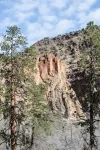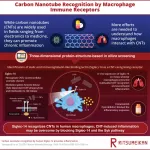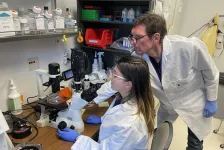(Press-News.org) When you walk through a forest, you are surrounded by carbon. Every branch and every leaf, every inch of trunk and every tendril of unseen root contains carbon pulled from the atmosphere through photosynthesis. And as long as it stays stored away inside that forest, it’s not contributing to the rising concentrations of carbon dioxide that cause climate change. So it’s only natural that we might want to use forests’ carbon-storage superpower as a potential climate solution in addition to reducing human greenhouse gas emissions.
But climate change itself might compromise how permanently forests are able to store carbon and keep it out of the air, according to a new paper by researchers at University of Utah and UC Santa Barbara. The study considered how different regions and tree species will respond to climate change. The authors found a wide range of estimates for the amount of carbon that forests in different regions might gain or lose as the climate warms. Importantly, the researchers found that regions most at risk of losing forest carbon through fire, climate stress or insect damage are precisely those regions where many forest carbon offset projects have been set up.
“Forest health and carbon-storage potential is evolving rapidly due to climate change,” said co-author Anna Trugman, an assistant professor at UC Santa Barbara. “The balance of increasing productivity from higher CO2 levels and accelerating losses from disturbances will determine the fate of forests as a carbon sink.”
The study appears in Nature Geoscience. The authors also created an interactive tool showing aboveground, live carbon storage potential in forests across the contiguous United States by the end of the century.
“This tells us there’s a really urgent need to update these carbon offsets protocols and policies with the best available science of climate risks to U.S. forests,” said University of Utah’s William Anderegg, the study’s senior author.
A multi-perspective modeling approach
The researchers hoped to forecast changes in the amount of aboveground carbon storage in forests of different regions in the U.S. Aboveground carbon refers to any living parts of a tree that are above ground, including wood and leaves or needles.
Scientists can look at the future of forests under climate change in a few different ways. They can consider historical and future projections of the climate, or examine datasets from long-term forest plots. They can also use machine learning to identify which climate niches different tree species most prefer. Or they can use complex models that include interactions between the ecosystem and the atmosphere.
Anderegg and colleagues, including first author Chao Wu, chose all of the above. “Each different method has inherent advantages and limitations,” said Wu, a postdoctoral scholar at University of Utah. “No model is perfect.”
“By bringing in many different approaches and different model types and comparing them,” Anderegg said, “we can get a sense of what the different models are telling us and how we [can] learn to improve the models. And we might have much more confidence if all of the models and all of the approaches tell us the same story in a given region.”
The researchers found that, although the models’ forecasts differed in some ways, they showed some consistency in predictions of how different regions’ carbon storage might change in the future. The Great Lakes and Northeastern U.S., for example, as well as parts of the Southeastern U.S. and the northern Rockies, consistently showed carbon gains in future projections.
But the models also revealed significant risks of losing carbon from forests through the triple threat of fire, climate stress and insect damage. Without these stresses, forests might be able to pack away 9.4 petagrams of carbon nationwide by the end of the 21st century. A petagram is equal to a quadrillion grams — about 25 times the mass of all humans on Earth. However, with these risks, the models projected a net gain in forests of between 3 and 5 petagrams.
The researchers also applied their analysis to 139 current projects aiming to offset carbon emissions by increasing the carbon stored in forests. “For carbon offsets to be effective,” Anderegg said, “they have to store carbon for a pretty long amount of time — multiple decades to centuries. So if fire’s burning them down or insects are wiping out different areas, it could vastly undermine their effectiveness as climate change solutions.”
Depending on the model method and the climate scenario, the researchers found that large numbers of carbon offset forest projects, particularly in the Southeastern U.S. and on the West Coast, are projected to lose carbon by the end of the century.
What we still need to know
The results highlight that different climate and ecological models have different strengths and weaknesses, and considering them together reveals the areas of research needed to improve climate projections.
Tree demographic models, for example, include simulations of forest dynamics as old trees die and new trees grow. “But these current models didn't consider the disturbance-vegetation feedback,” Wu said, referring to the different types of vegetation besides trees that appear following a disturbance like a forest fire and how they might influence the odds of another disturbance. “Also they didn’t consider CO2 fertilization,” or the potential for rising carbon dioxide levels to actually improve plant growth.
The authors identified three research questions that could help elucidate the situation. First is the extent to which plants and trees might benefit from rising CO2 concentrations, as the compound is vital for photosynthesis. Second is a need for better data on climate-driven tree mortality from fire, climate stress and insects to inform their understanding of these threats. Last, scientists need a better account of how biomes will shift. For example, some forests may be able to grow back after a disturbance, but others may transition to grasslands and be lost entirely. “These are some of the biggest unknowns that the field is really racing to tackle,” Anderegg said.
In the meantime, while science works to understand how climate change affects forests, society can help by slowing the pace of climate change. “Working to tackle climate change as quickly as possible and move to a lower carbon future massively decreases the risks that forests are likely to face in the 21st century,” Anderegg said, “and increases the potential benefits that we might get from forests.”
END
Forest futures
US forests face an unclear future with climate change
2023-04-06
ELSE PRESS RELEASES FROM THIS DATE:
Cancer researchers identify protein with novel anti-tumoral activities
2023-04-06
AURORA, Colo. (April 6, 2023) – Understanding how cancer develops is critical for designing effective, personalized cancer therapies. Researchers have known for years that cancer begins with mutations in certain types of genes. One of these types of cancer genes are so-called “tumor suppressors.” When functioning normally, tumor suppressor genes can stop malignant cells from undergoing uncontrolled cell proliferation and initiate a process of cell elimination called apoptosis, a form of cell death. Mutations in tumor suppressor genes can cause these genes to lose their functionality, eventually contributing to the development of cancer.
In a recent ...
Long-forgotten equation provides new tool for converting carbon dioxide
2023-04-06
ITHACA, N.Y. – To manage atmospheric carbon dioxide and convert the gas into a useful product, Cornell University scientists have dusted off an archaic – now 120 years old – electrochemical equation.
The calculation – named the Cottrell equation for chemist Frederick Gardner Cottrell, who developed it in 1903 – can help today’s researchers understand the several reactions that carbon dioxide can take when electrochemistry is applied and pulsed on a lab bench.
The electrochemical reduction of carbon dioxide presents an opportunity to transform the gas from an environmental liability to a feedstock ...
Anti-smoking campaigns on Facebook that discuss the risks of second-hand smoking to pets receive the most user engagement
2023-04-06
Currently, 12.5% of U.S. adults smoke cigarettes. At the same time, more than one-third of U.S. adults seek health information online, making social media a potentially powerful platform for anti-tobacco campaigns. However, limited research has been done on effective social media strategies for anti-smoking campaigns.
An interprofessional Mason research team led by Associate Professors in the Department of Health Administration and Policy Hong Xue and Gilbert Gimm found that the most popular anti-tobacco campaigns on Facebook were informational and discussed the negative effects of smoking. ...
Kessler Foundation receives Craig H. Neilsen grant to improve return-to-work and employment outcomes for inpatients with spinal cord injury
2023-04-06
East Hanover, NJ – April 6, 2023 – Ada Chen, PhD, at Kessler Foundation was awarded a two-year grant for $187,000 from the Craig H. Neilsen Foundation to improve the return-to-work rate and employment outcomes for inpatients with spinal cord injury (SCI). Her study is titled “Employment after SCI: Stakeholder Perceptions and Experiences of Vocational Resource Facilitation.”
“The Vocational Resource Facilitation (VRF) pilot project – developed as an early intervention – has already shown promising outcomes in improving return-to-work rates,” said Dr. Chen. “Further investigation of VRF participant and stakeholder experiences and perceptions ...
Novel immunotherapy agent safe, shows promise against high-risk prostate cancers
2023-04-06
FOR IMMEDIATE RELEASE
A new drug, a monoclonal antibody known as enoblituzumab, is safe in men with aggressive prostate cancer and may induce clinical activity against cancer throughout the body, according to a phase 2 study led by investigators at the Johns Hopkins Kimmel Cancer Center and its Bloomberg~Kimmel Institute for Cancer Immunotherapy. If confirmed in additional studies, enoblituzumab could become the first promising antibody-based immunotherapy agent against prostate cancer.
In a clinical trial, 32 men with high-risk or very high-risk prostate cancers who were scheduled ...
Fiery response: “Siglec-14” receptors on human macrophages detect carbon nanotubes and provoke inflammation, finds study
2023-04-06
Carbon nanotubes (CNTs) have become a mainstay of the field of nanotechnology. Finding innovative applications across materials science, electronics, and medicine, CNTs have garnered a lot of attention from researchers in recent years. However, the International Chemical Secretariat (ChemSec) has moved to flag CNTs on the “Substitute It Now!” database of chemicals likely to be restricted for use. In fact, due to their persistence in nature and potential toxicity to humans, ChemSec has proposed that adequate assessments of CNTs' risk to human health are urgently needed.
Following their entry into the body, and much like asbestos, CNTs are targeted by the immune system and preferentially ...
Alternative glucose breakdown ensures the survival of cancer cells
2023-04-06
A key enzyme in sugar metabolism is inactivated particularly easily and efficiently by oxidative stress. Scientists at the German Cancer Research Center (Deutsches Krebsforschungszentrum, DKFZ) have now shown that with this oxidation, cells switch to an alternative sugar breakdown pathway and can thus escape oxidative stress. Cancer cells in particular benefit from this mechanism, which can also protect them from therapy-related damage.
One of the central enzymes in sugar breakdown, GAPDH (glyceraldehyde-3-phosphate dehydrogenase), ...
Super-sized nanocage could deliver bigger drug cargoes
2023-04-06
Think about how frustrating it is to try to fit a gift into a box that is too small. Sometimes you just need a bigger box.
Building a bigger box
Nanocages are tiny artificial containers that can be used to deliver therapeutics to a target destination in the body. But some drug molecules are like gifts that are too big for a standard-sized nanocage ‘box’. Now, in an article published today in Nature Synthesis, researchers from the University of Cambridge describe how they have built a super-sized nanocage that could be used to deliver larger drug cargoes. They have built a bigger box.
Simple building blocks
Rational control over the self-assembly of these types of cages generally ...
Shedding light on mechanisms of electrochemical energy storage
2023-04-06
Understanding why certain materials work better than others when it comes to energy storage is a crucial step for developing the batteries that will power electronic devices, electric vehicles and renewable energy grids. Researchers at Drexel University have developed a new technique that can quickly identify the exact electrochemical mechanisms taking place in batteries and supercapacitors of various compositions — a breakthrough that could speed the design of higher performing energy storage devices.
Reported in Nature Energy, the Drexel team’s ...
Researchers tackle major obstacle to stem-cell heart repair
2023-04-06
Researchers at the University of Washington School of Medicine in Seattle have engineered stem cells that do not generate dangerous arrhythmias, a complication that has to date thwarted efforts to develop stem-cell therapies for injured hearts.
“We have found what we have to tackle to make these cells safe,” said Silvia Marchiano, a postdoctoral fellow in the laboratory of Chuck Murry at the UW Medicine Institute for Stem Cell and Regenerative Medicine. Marchiano is the lead author of a paper describing the findings published Thursday, April ...
LAST 30 PRESS RELEASES:
Post-stroke injection protects the brain in preclinical study
Cardiovascular risk score predicts multiple eye diseases
Health: estimated one in ten British adults used or interested in GLP-1 medications for weight loss
Exercise to treat depression yields similar results to therapy
Whooping cough vaccination for pregnant women strengthens babies’ immune system
Dramatic decline in new cases of orphanhood in Uganda driven by HIV treatment and prevention programs
Stopping weight loss drugs linked to weight regain and reversal of heart health markers
Higher intake of food preservatives linked to increased cancer risk
Mass General Brigham–developed cholera vaccine completes phase 1 trial
First experimental validation of a “150-year-old chemical common sense” direct visualization of the molecular structural changes in the ultrafast anthracene [4+4] photocycloaddition reaction
Lack of support for people on weight loss drugs leaves them vulnerable to nutritional deficiencies, say experts
Dogs’ dinners can have greater climate impact than owners’
Are you ready to swap salmon for sprats and sardines?
1.6 million UK adults used weight loss drugs in past year
American College of Cardiology comments on new dietary guidelines for Americans
American Society of Gene & Cell Therapy and Orphan Therapeutics Accelerator partner to advance and commercialize promising rare disease treatments
One in 14 patients having day case surgery have new or worse chronic pain 3 months after their operation
New study highlights link between eviction rates and gun violence
Heatwaves heat up soil but not toxin levels in rice, study finds
Digital modeling reveals where construction carbon emissions really come from
Turning farm waste into water filters
New study shows how the spleen helps the immune system accept a transplant
New Mayo Clinic study advances personalized prostate cancer education with an EHR-integrated AI agent
Researchers identify novel therapeutic target to improve recovery after nerve injury
Microbes in breast milk help populate infant gut microbiomes
Reprogramming immunity to rewrite the story of Type 1 diabetes
New tool narrows the search for ideal material structures
Artificial saliva containing sugarcane protein helps protect the teeth of patients with head and neck cancer
Understanding the role of linear ubiquitination in T-tubule biogenesis
Researchers identify urban atmosphere as primary reservoir of microplastics
[Press-News.org] Forest futuresUS forests face an unclear future with climate change




